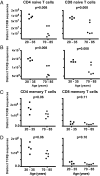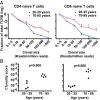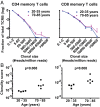Diversity and clonal selection in the human T-cell repertoire
- PMID: 25157137
- PMCID: PMC4246948
- DOI: 10.1073/pnas.1409155111
Diversity and clonal selection in the human T-cell repertoire
Abstract
T-cell receptor (TCR) diversity, a prerequisite for immune system recognition of the universe of foreign antigens, is generated in the first two decades of life in the thymus and then persists to an unknown extent through life via homeostatic proliferation of naïve T cells. We have used next-generation sequencing and nonparametric statistical analysis to estimate a lower bound for the total number of different TCR beta (TCRB) sequences in human repertoires. We arrived at surprisingly high minimal estimates of 100 million unique TCRB sequences in naïve CD4 and CD8 T-cell repertoires of young adults. Naïve repertoire richness modestly declined two- to fivefold in healthy elderly. Repertoire richness contraction with age was even less pronounced for memory CD4 and CD8 T cells. In contrast, age had a major impact on the inequality of clonal sizes, as estimated by a modified Gini-Simpson index clonality score. In particular, large naïve T-cell clones that were distinct from memory clones were found in the repertoires of elderly individuals, indicating uneven homeostatic proliferation without development of a memory cell phenotype. Our results suggest that a highly diverse repertoire is maintained despite thymic involution; however, peripheral fitness selection of T cells leads to repertoire perturbations that can influence the immune response in the elderly.
Keywords: T-cell homeostasis; adaptive immune responses; aging; immunosenescence.
Conflict of interest statement
The authors declare no conflict of interest.
Figures





References
Publication types
MeSH terms
Substances
Associated data
Grants and funding
- R01 AI044142/AI/NIAID NIH HHS/United States
- P01 HL058000/HL/NHLBI NIH HHS/United States
- U19 AI090019/AI/NIAID NIH HHS/United States
- R01 AG015043/AG/NIA NIH HHS/United States
- U19 AI057266/AI/NIAID NIH HHS/United States
- R01 AR042527/AR/NIAMS NIH HHS/United States
- R01 AG045779/AG/NIA NIH HHS/United States
- R01 HL117913/HL/NHLBI NIH HHS/United States
- R01 AI108906/AI/NIAID NIH HHS/United States
- T32 AR050942/AR/NIAMS NIH HHS/United States
- R56 AI044142/AI/NIAID NIH HHS/United States
- R01 AI108891/AI/NIAID NIH HHS/United States
LinkOut - more resources
Full Text Sources
Other Literature Sources
Research Materials

